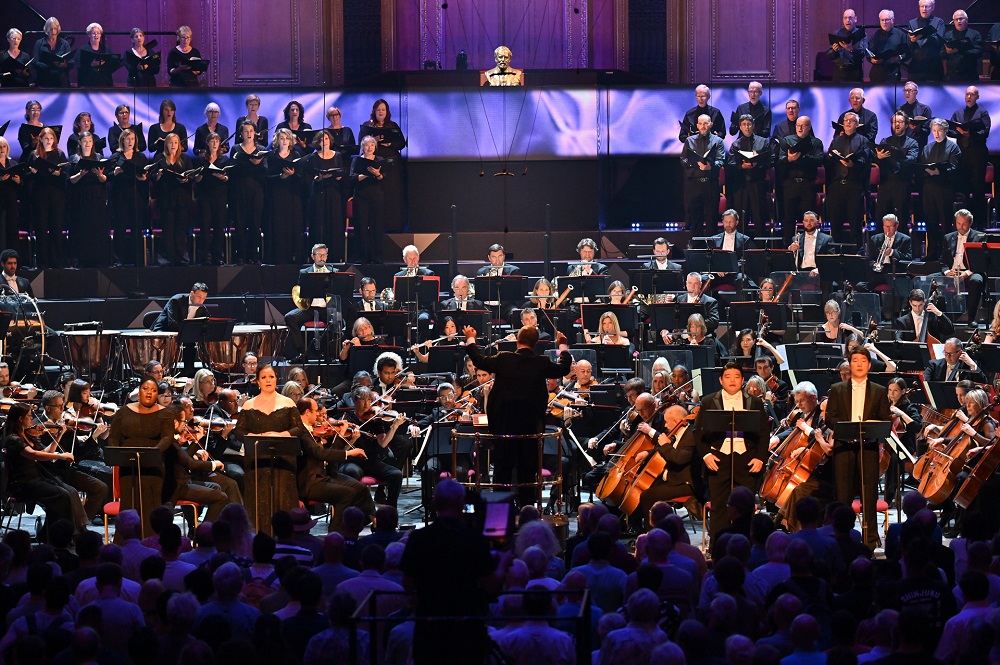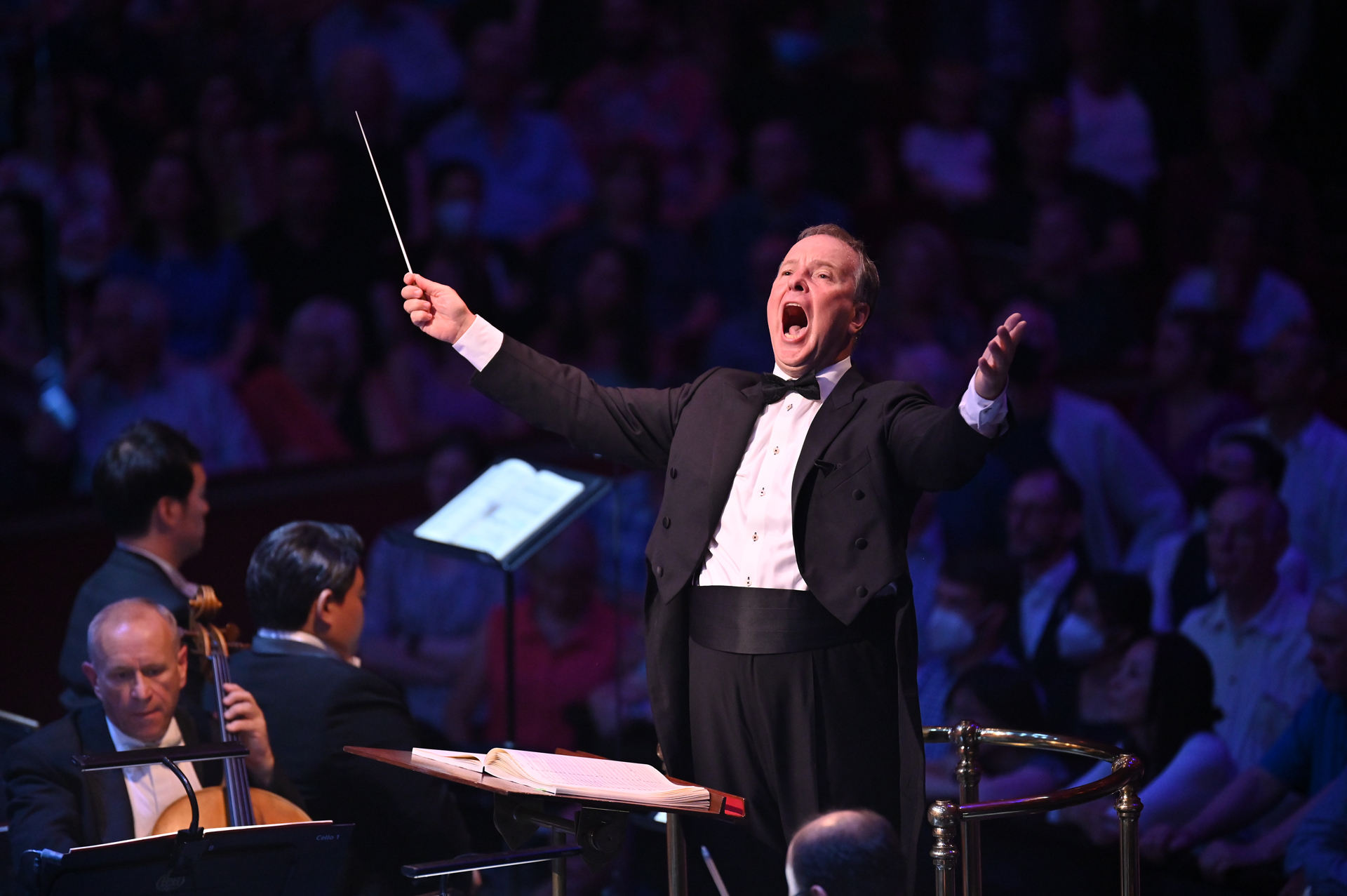Prom 1, Verdi's Requiem, BBCSO, Oramo review - introspective sorrow and consolation between the blazes | reviews, news & interviews
Prom 1, Verdi's Requiem, BBCSO, Oramo review - introspective sorrow and consolation between the blazes
Prom 1, Verdi's Requiem, BBCSO, Oramo review - introspective sorrow and consolation between the blazes
Masabane Cecilia Rangwanasha is the light that burns brightest in a hallowed ritual
Any sensitive festival planner knows to begin the return to a new normal with something soft and elegiac – reflecting on all we’ve lost and mourned these past two years, as well as what we’re facing in the world now. Just over a fortnight ago, at the East Neuk Festival, the Elias Quartet led us gently by the hand with James MacMillan’s Memento. The 2022 BBC Proms began pianissimo, massed forces at the ready for the intermittent blazes of Verdi’s Requiem.
It should have been a moving start to a Proms season which is rightly celebrating the big and the awe-inspiring. But those two years have perhaps also made us forget what unfolded in counterpoint: hacking coughs no longer discreetly masked, bottles and mobile phones clattering to the ground, the scrunching of a plastic water bottle four along (how did she do it?)
That’s what happens when you finally get 5000 people in the vasts of the Royal Albert Hall (the Prommers in the Arena are mostly, of course, rapt and intently quiet). Sakari Oramo dared to make his BBC Symphony Orchestra and the choruses as mysteriously quiet as possible – which I hope worked better on TV and radio – but it was only with the entry of the four splendid soloists that those of us distracted by unneighbourly antics felt ourselves pulled in to the expressive focus. 
Ultimately, with the Libera me, it's the soprano who has to make the biggest impression. It was obvious from her peerless, mature performance of Elisabetta's big aria in Don Carlo at the BBC Cardiff Singer of the World competition - the outstanding offering of the finale, though three of the other finalists were also superb – that Masabane Cecilia Rangwanasha (pictured below with Johnston to the right) would excel. Her commitment, involvement, referencing of Oramo when it most mattered were allied to a voice which may seem naturally lyric, but can still pull out the big guns when necessary. 
But then if you don't at least have tears in your eyes at several points in Verdi's great masterpiece, it hasn't worked. They came thick and fast from the first ensemble of soloists and chorus onwards, and the BBC Symphony Orchestra woodwind principals were as much stars in making it happen as the vocal soloists, above all flautist Daniel Pailthorpe (and the flute trio meshing with the soprano and mezzo in octaves is such a slice of heaven), Alison Teale's miraculously phrased oboe solo in the "Ingemisco" and Julie Price making you hear more singing in the first bassoon part than I've ever noticed before. Brass ensembles were rich and thrilling, the spatial effects of the "Tuba mirum" never better than in the Albert Hall, while the combined forces of the BBC Symphony Chorus and Crouch End Festival Chorus ran the dynamic gamut with perfect focus. 
rating
Explore topics
Share this article
Add comment
The future of Arts Journalism
You can stop theartsdesk.com closing!
We urgently need financing to survive. Our fundraising drive has thus far raised £49,000 but we need to reach £100,000 or we will be forced to close. Please contribute here: https://gofund.me/c3f6033d
And if you can forward this information to anyone who might assist, we’d be grateful.

Subscribe to theartsdesk.com
Thank you for continuing to read our work on theartsdesk.com. For unlimited access to every article in its entirety, including our archive of more than 15,000 pieces, we're asking for £5 per month or £40 per year. We feel it's a very good deal, and hope you do too.
To take a subscription now simply click here.
And if you're looking for that extra gift for a friend or family member, why not treat them to a theartsdesk.com gift subscription?
more Classical music
 Echo Vocal Ensemble, Latto, Union Chapel review - eclectic choral programme garlanded with dance
Beautiful singing at the heart of an imaginative and stylistically varied concert
Echo Vocal Ensemble, Latto, Union Chapel review - eclectic choral programme garlanded with dance
Beautiful singing at the heart of an imaginative and stylistically varied concert
 Scott, Irish Baroque Orchestra, Whelan, RIAM, Dublin review - towards a Mozart masterpiece
Characteristic joy and enlightenment from this team, but a valveless horn brings problems
Scott, Irish Baroque Orchestra, Whelan, RIAM, Dublin review - towards a Mozart masterpiece
Characteristic joy and enlightenment from this team, but a valveless horn brings problems
 Classical CDs: Voice flutes, flugelhorns and froth
Baroque sonatas, English orchestral music and an emotionally-charged vocal recital
Classical CDs: Voice flutes, flugelhorns and froth
Baroque sonatas, English orchestral music and an emotionally-charged vocal recital
 Kanneh-Mason, Britten Sinfonia, Shave, Milton Court - a grin and a big beaming smile
A pair of striking contemporary pieces alongside two old favourites
Kanneh-Mason, Britten Sinfonia, Shave, Milton Court - a grin and a big beaming smile
A pair of striking contemporary pieces alongside two old favourites
 theartsdesk at the New Ross Piano Festival - Finghin Collins’ musical rainbow
From revelatory Bach played with astounding maturity by a 22 year old to four-hand jazz
theartsdesk at the New Ross Piano Festival - Finghin Collins’ musical rainbow
From revelatory Bach played with astounding maturity by a 22 year old to four-hand jazz
 First Person: Manchester Camerata's Head of Artistic Planning Clara Marshall Cawley on questioning the status quo
Five days of free events with all sorts of audiences around Manchester starts tomorrow
First Person: Manchester Camerata's Head of Artistic Planning Clara Marshall Cawley on questioning the status quo
Five days of free events with all sorts of audiences around Manchester starts tomorrow
 Goldscheider, Brother Tree Sound, Kings Place review - music of hope from a young composer
Unusual combination of horn, strings and electronics makes for some intriguing listening
Goldscheider, Brother Tree Sound, Kings Place review - music of hope from a young composer
Unusual combination of horn, strings and electronics makes for some intriguing listening
 theartsdesk Q&A: composer Donghoon Shin on his new concerto for pianist Seong-Jin Cho
Classical music makes its debut at London's K-Music Festival
theartsdesk Q&A: composer Donghoon Shin on his new concerto for pianist Seong-Jin Cho
Classical music makes its debut at London's K-Music Festival
 Helleur-Simcock, Hallé, Wong, Bridgewater Hall, Manchester review - moving lyricism in Elgar’s concerto
Season opener brings lyrical beauty, crisp confidence and a proper Romantic wallow
Helleur-Simcock, Hallé, Wong, Bridgewater Hall, Manchester review - moving lyricism in Elgar’s concerto
Season opener brings lyrical beauty, crisp confidence and a proper Romantic wallow
 Kohout, Spence, Braun, Manchester Camerata, Huth, RNCM, Manchester review - joy, insight, imagination and unanimity
Celebration of the past with stars of the future at the Royal Northern College
Kohout, Spence, Braun, Manchester Camerata, Huth, RNCM, Manchester review - joy, insight, imagination and unanimity
Celebration of the past with stars of the future at the Royal Northern College

Comments
first night of the proms 2022
Probably you're referring to
Probably you're referring to the ophicleide, much beloved of Berlioz - comes in several sizes but the biggest is seen as forerunner of the tuba. From where I was sitting, I couldn't see, but I'm sure it loomed large on the telly.
It was a cimbasso which is a
Thanks for the clarification,
Thanks for the clarification, Michael. Next, bring on the Aida trumpets.